Toxicology Report: Comprehensive Analysis of Anti-Cancer Drug Testing
VerifiedAdded on 2020/04/21
|10
|1878
|147
Report
AI Summary
This report delves into the field of toxicology, specifically focusing on the evaluation of anti-cancer drugs. It explores various testing methodologies, including cell culture or tissue culture, animal models or xenograft models, and computer simulations models. The report emphasizes the import...
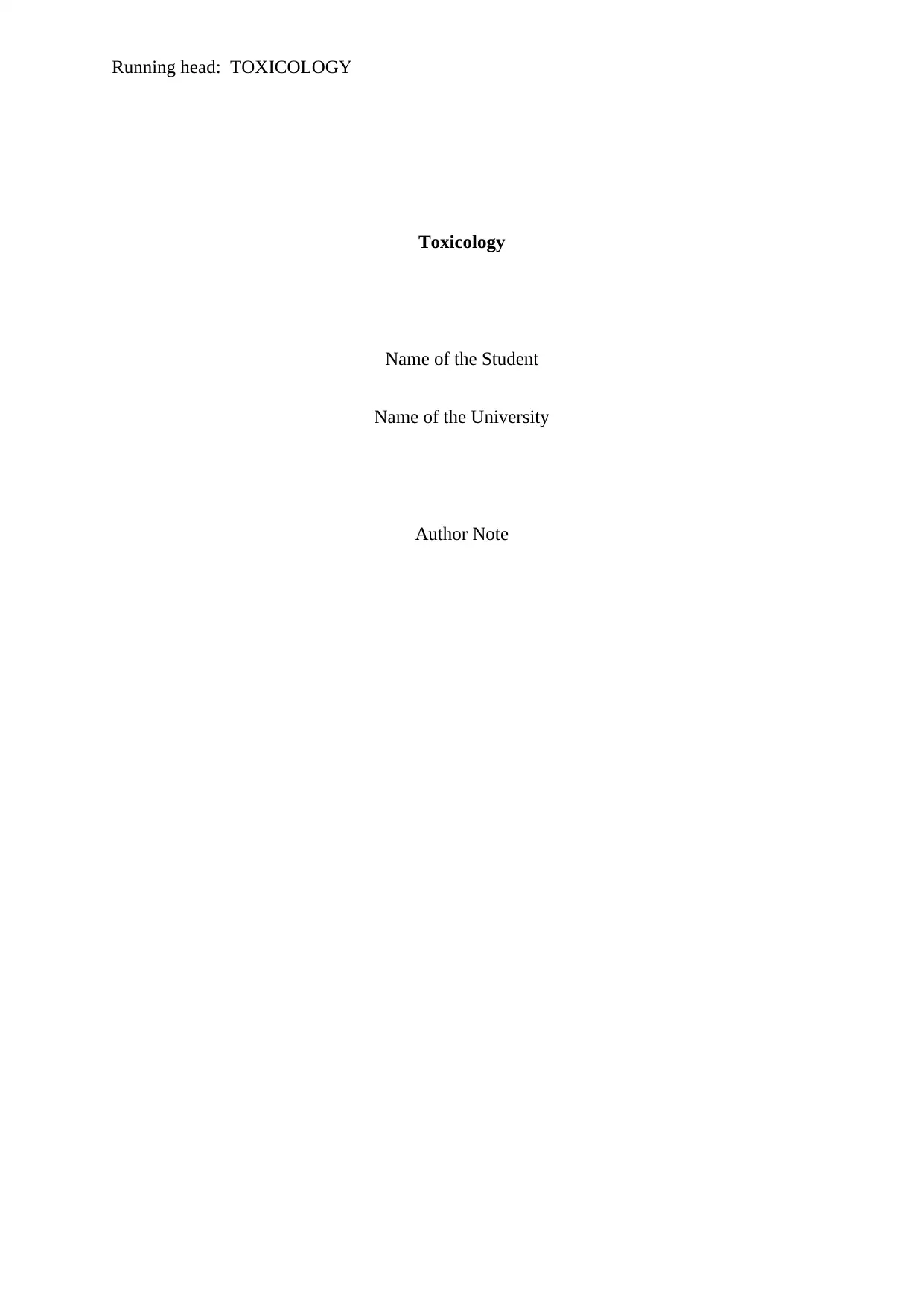
Running head: TOXICOLOGY
Toxicology
Name of the Student
Name of the University
Author Note
Toxicology
Name of the Student
Name of the University
Author Note
Paraphrase This Document
Need a fresh take? Get an instant paraphrase of this document with our AI Paraphraser
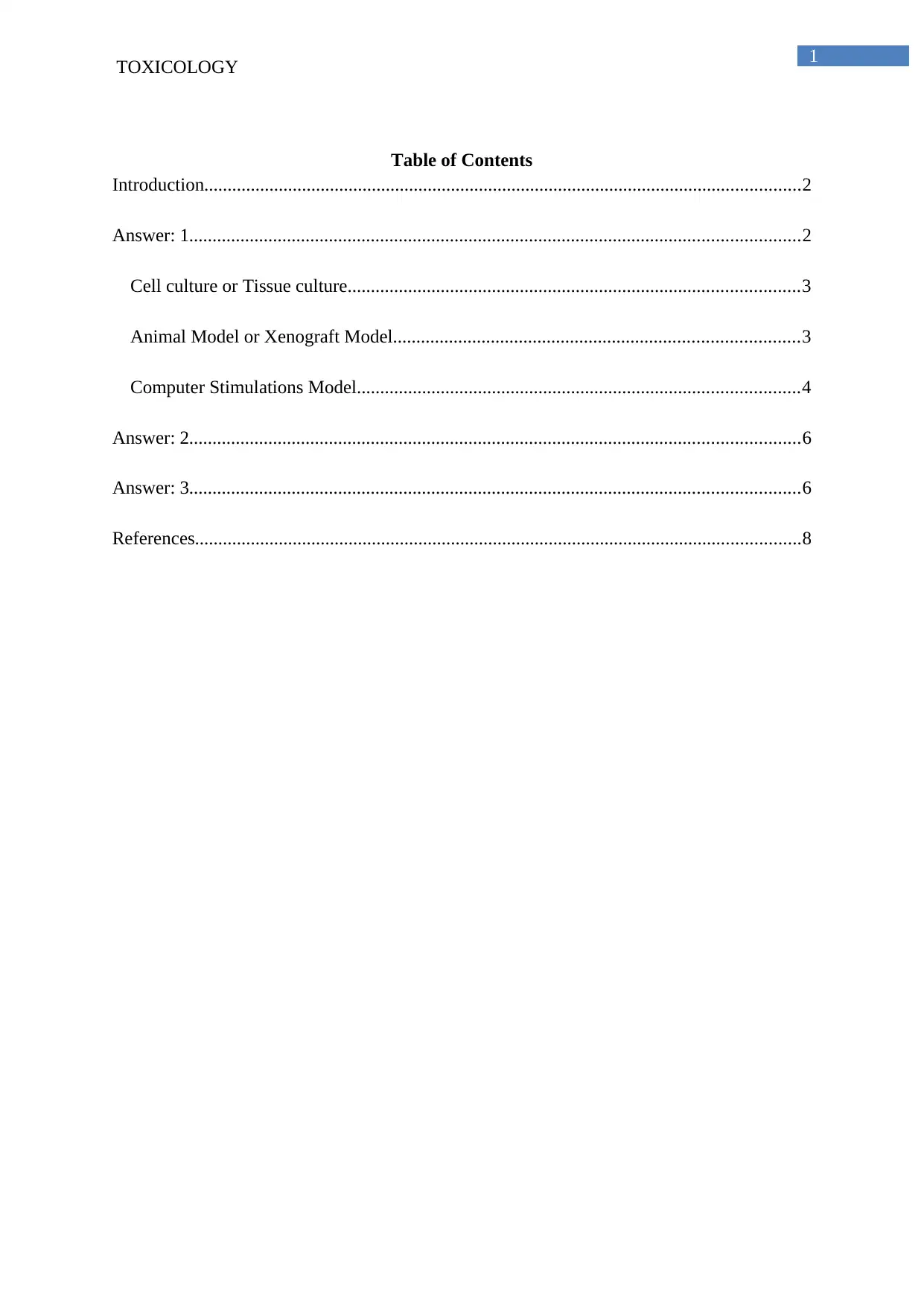
1
TOXICOLOGY
Table of Contents
Introduction................................................................................................................................2
Answer: 1...................................................................................................................................2
Cell culture or Tissue culture.................................................................................................3
Animal Model or Xenograft Model.......................................................................................3
Computer Stimulations Model...............................................................................................4
Answer: 2...................................................................................................................................6
Answer: 3...................................................................................................................................6
References..................................................................................................................................8
TOXICOLOGY
Table of Contents
Introduction................................................................................................................................2
Answer: 1...................................................................................................................................2
Cell culture or Tissue culture.................................................................................................3
Animal Model or Xenograft Model.......................................................................................3
Computer Stimulations Model...............................................................................................4
Answer: 2...................................................................................................................................6
Answer: 3...................................................................................................................................6
References..................................................................................................................................8
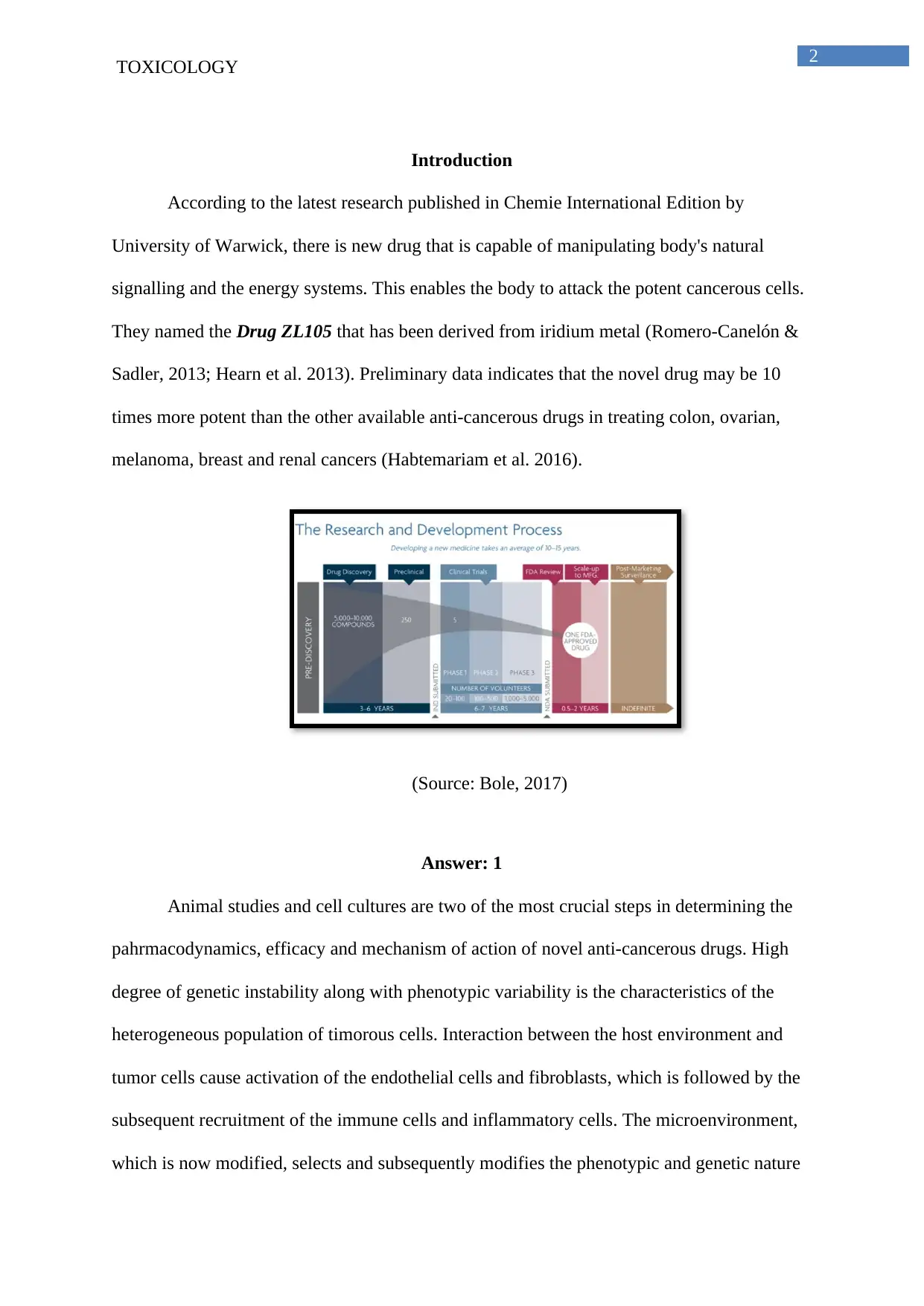
2
TOXICOLOGY
Introduction
According to the latest research published in Chemie International Edition by
University of Warwick, there is new drug that is capable of manipulating body's natural
signalling and the energy systems. This enables the body to attack the potent cancerous cells.
They named the Drug ZL105 that has been derived from iridium metal (Romero-Canelón &
Sadler, 2013; Hearn et al. 2013). Preliminary data indicates that the novel drug may be 10
times more potent than the other available anti-cancerous drugs in treating colon, ovarian,
melanoma, breast and renal cancers (Habtemariam et al. 2016).
(Source: Bole, 2017)
Answer: 1
Animal studies and cell cultures are two of the most crucial steps in determining the
pahrmacodynamics, efficacy and mechanism of action of novel anti-cancerous drugs. High
degree of genetic instability along with phenotypic variability is the characteristics of the
heterogeneous population of timorous cells. Interaction between the host environment and
tumor cells cause activation of the endothelial cells and fibroblasts, which is followed by the
subsequent recruitment of the immune cells and inflammatory cells. The microenvironment,
which is now modified, selects and subsequently modifies the phenotypic and genetic nature
TOXICOLOGY
Introduction
According to the latest research published in Chemie International Edition by
University of Warwick, there is new drug that is capable of manipulating body's natural
signalling and the energy systems. This enables the body to attack the potent cancerous cells.
They named the Drug ZL105 that has been derived from iridium metal (Romero-Canelón &
Sadler, 2013; Hearn et al. 2013). Preliminary data indicates that the novel drug may be 10
times more potent than the other available anti-cancerous drugs in treating colon, ovarian,
melanoma, breast and renal cancers (Habtemariam et al. 2016).
(Source: Bole, 2017)
Answer: 1
Animal studies and cell cultures are two of the most crucial steps in determining the
pahrmacodynamics, efficacy and mechanism of action of novel anti-cancerous drugs. High
degree of genetic instability along with phenotypic variability is the characteristics of the
heterogeneous population of timorous cells. Interaction between the host environment and
tumor cells cause activation of the endothelial cells and fibroblasts, which is followed by the
subsequent recruitment of the immune cells and inflammatory cells. The microenvironment,
which is now modified, selects and subsequently modifies the phenotypic and genetic nature
⊘ This is a preview!⊘
Do you want full access?
Subscribe today to unlock all pages.

Trusted by 1+ million students worldwide
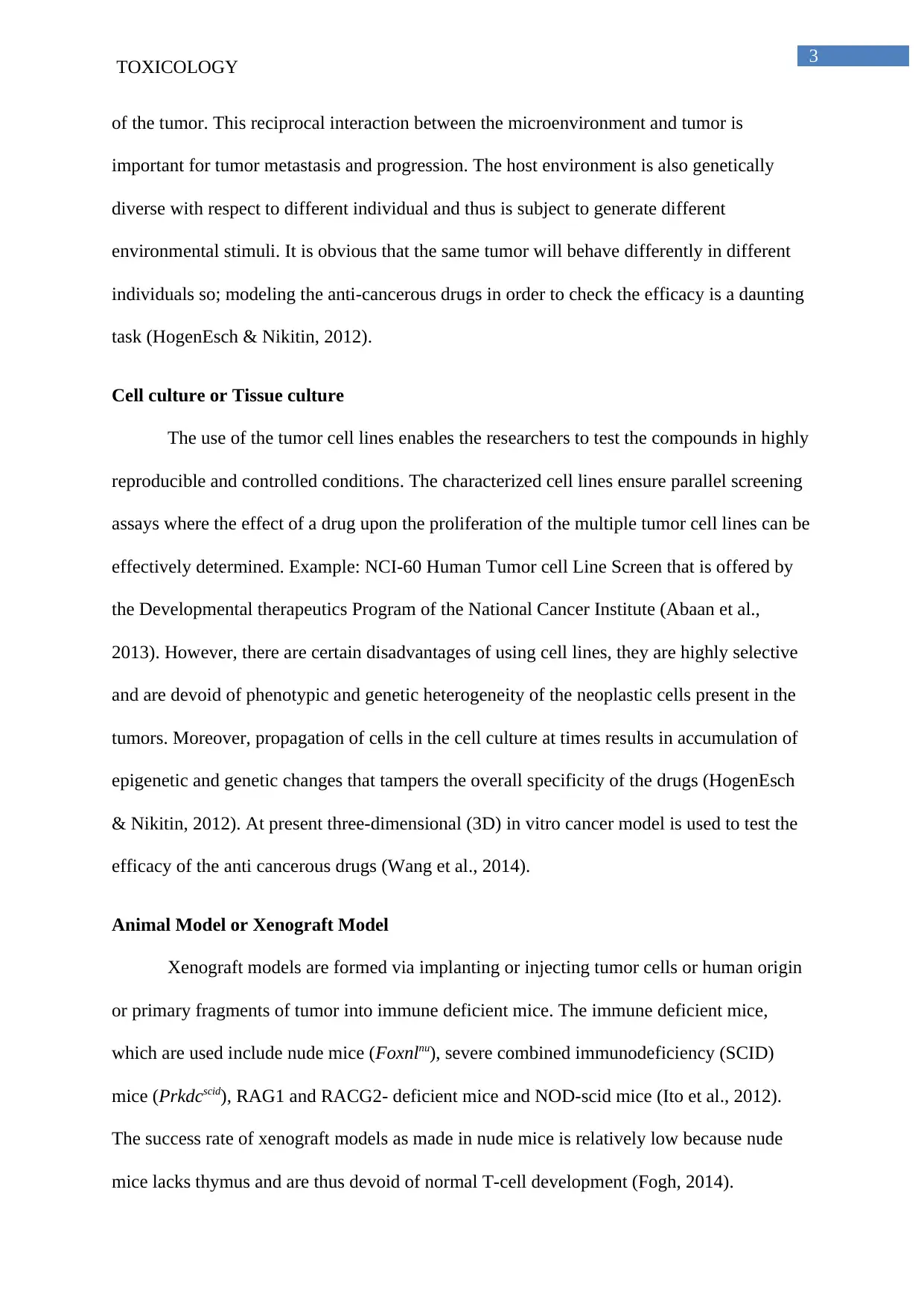
3
TOXICOLOGY
of the tumor. This reciprocal interaction between the microenvironment and tumor is
important for tumor metastasis and progression. The host environment is also genetically
diverse with respect to different individual and thus is subject to generate different
environmental stimuli. It is obvious that the same tumor will behave differently in different
individuals so; modeling the anti-cancerous drugs in order to check the efficacy is a daunting
task (HogenEsch & Nikitin, 2012).
Cell culture or Tissue culture
The use of the tumor cell lines enables the researchers to test the compounds in highly
reproducible and controlled conditions. The characterized cell lines ensure parallel screening
assays where the effect of a drug upon the proliferation of the multiple tumor cell lines can be
effectively determined. Example: NCI-60 Human Tumor cell Line Screen that is offered by
the Developmental therapeutics Program of the National Cancer Institute (Abaan et al.,
2013). However, there are certain disadvantages of using cell lines, they are highly selective
and are devoid of phenotypic and genetic heterogeneity of the neoplastic cells present in the
tumors. Moreover, propagation of cells in the cell culture at times results in accumulation of
epigenetic and genetic changes that tampers the overall specificity of the drugs (HogenEsch
& Nikitin, 2012). At present three-dimensional (3D) in vitro cancer model is used to test the
efficacy of the anti cancerous drugs (Wang et al., 2014).
Animal Model or Xenograft Model
Xenograft models are formed via implanting or injecting tumor cells or human origin
or primary fragments of tumor into immune deficient mice. The immune deficient mice,
which are used include nude mice (Foxnlnu), severe combined immunodeficiency (SCID)
mice (Prkdcscid), RAG1 and RACG2- deficient mice and NOD-scid mice (Ito et al., 2012).
The success rate of xenograft models as made in nude mice is relatively low because nude
mice lacks thymus and are thus devoid of normal T-cell development (Fogh, 2014).
TOXICOLOGY
of the tumor. This reciprocal interaction between the microenvironment and tumor is
important for tumor metastasis and progression. The host environment is also genetically
diverse with respect to different individual and thus is subject to generate different
environmental stimuli. It is obvious that the same tumor will behave differently in different
individuals so; modeling the anti-cancerous drugs in order to check the efficacy is a daunting
task (HogenEsch & Nikitin, 2012).
Cell culture or Tissue culture
The use of the tumor cell lines enables the researchers to test the compounds in highly
reproducible and controlled conditions. The characterized cell lines ensure parallel screening
assays where the effect of a drug upon the proliferation of the multiple tumor cell lines can be
effectively determined. Example: NCI-60 Human Tumor cell Line Screen that is offered by
the Developmental therapeutics Program of the National Cancer Institute (Abaan et al.,
2013). However, there are certain disadvantages of using cell lines, they are highly selective
and are devoid of phenotypic and genetic heterogeneity of the neoplastic cells present in the
tumors. Moreover, propagation of cells in the cell culture at times results in accumulation of
epigenetic and genetic changes that tampers the overall specificity of the drugs (HogenEsch
& Nikitin, 2012). At present three-dimensional (3D) in vitro cancer model is used to test the
efficacy of the anti cancerous drugs (Wang et al., 2014).
Animal Model or Xenograft Model
Xenograft models are formed via implanting or injecting tumor cells or human origin
or primary fragments of tumor into immune deficient mice. The immune deficient mice,
which are used include nude mice (Foxnlnu), severe combined immunodeficiency (SCID)
mice (Prkdcscid), RAG1 and RACG2- deficient mice and NOD-scid mice (Ito et al., 2012).
The success rate of xenograft models as made in nude mice is relatively low because nude
mice lacks thymus and are thus devoid of normal T-cell development (Fogh, 2014).
Paraphrase This Document
Need a fresh take? Get an instant paraphrase of this document with our AI Paraphraser
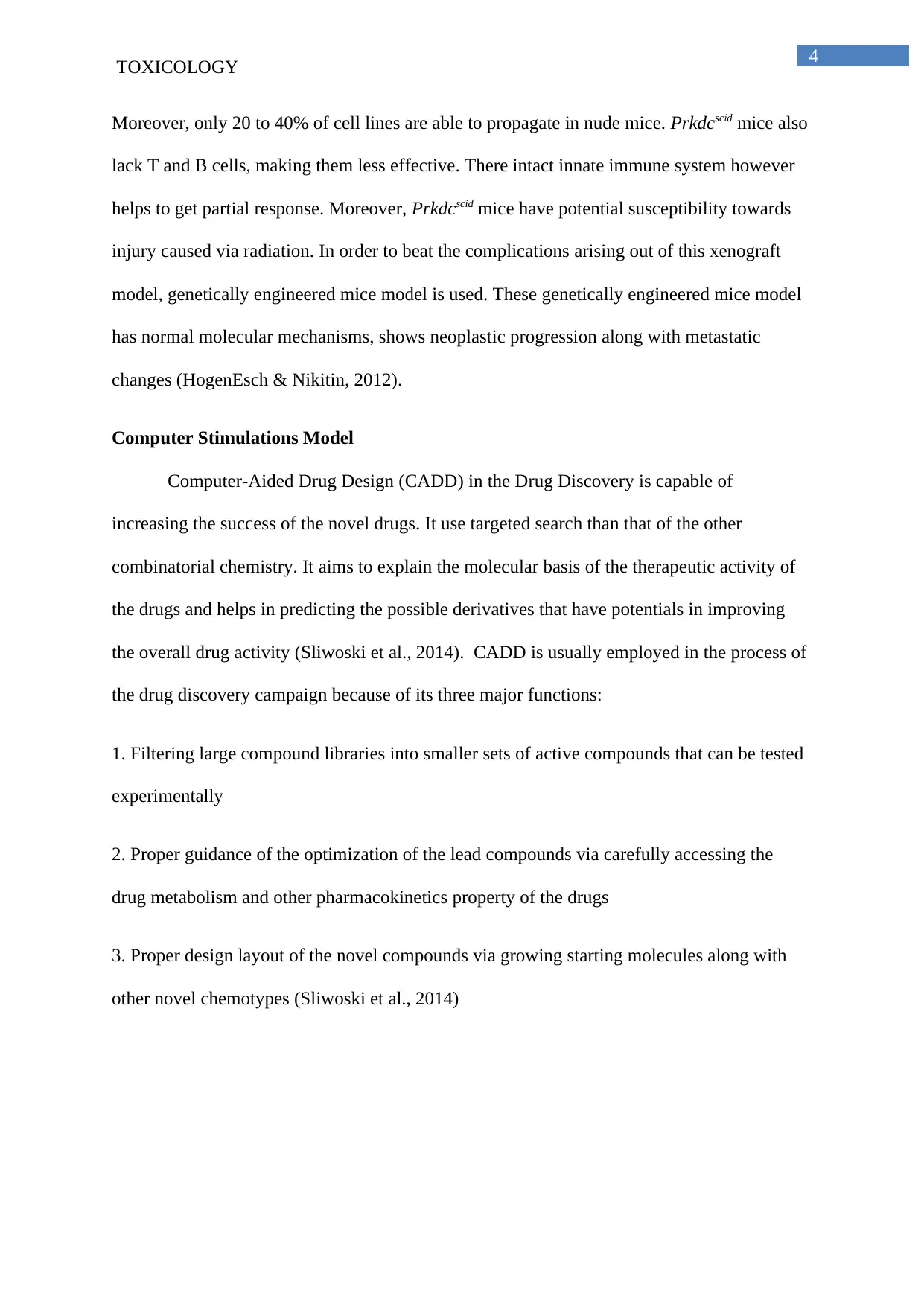
4
TOXICOLOGY
Moreover, only 20 to 40% of cell lines are able to propagate in nude mice. Prkdcscid mice also
lack T and B cells, making them less effective. There intact innate immune system however
helps to get partial response. Moreover, Prkdcscid mice have potential susceptibility towards
injury caused via radiation. In order to beat the complications arising out of this xenograft
model, genetically engineered mice model is used. These genetically engineered mice model
has normal molecular mechanisms, shows neoplastic progression along with metastatic
changes (HogenEsch & Nikitin, 2012).
Computer Stimulations Model
Computer-Aided Drug Design (CADD) in the Drug Discovery is capable of
increasing the success of the novel drugs. It use targeted search than that of the other
combinatorial chemistry. It aims to explain the molecular basis of the therapeutic activity of
the drugs and helps in predicting the possible derivatives that have potentials in improving
the overall drug activity (Sliwoski et al., 2014). CADD is usually employed in the process of
the drug discovery campaign because of its three major functions:
1. Filtering large compound libraries into smaller sets of active compounds that can be tested
experimentally
2. Proper guidance of the optimization of the lead compounds via carefully accessing the
drug metabolism and other pharmacokinetics property of the drugs
3. Proper design layout of the novel compounds via growing starting molecules along with
other novel chemotypes (Sliwoski et al., 2014)
TOXICOLOGY
Moreover, only 20 to 40% of cell lines are able to propagate in nude mice. Prkdcscid mice also
lack T and B cells, making them less effective. There intact innate immune system however
helps to get partial response. Moreover, Prkdcscid mice have potential susceptibility towards
injury caused via radiation. In order to beat the complications arising out of this xenograft
model, genetically engineered mice model is used. These genetically engineered mice model
has normal molecular mechanisms, shows neoplastic progression along with metastatic
changes (HogenEsch & Nikitin, 2012).
Computer Stimulations Model
Computer-Aided Drug Design (CADD) in the Drug Discovery is capable of
increasing the success of the novel drugs. It use targeted search than that of the other
combinatorial chemistry. It aims to explain the molecular basis of the therapeutic activity of
the drugs and helps in predicting the possible derivatives that have potentials in improving
the overall drug activity (Sliwoski et al., 2014). CADD is usually employed in the process of
the drug discovery campaign because of its three major functions:
1. Filtering large compound libraries into smaller sets of active compounds that can be tested
experimentally
2. Proper guidance of the optimization of the lead compounds via carefully accessing the
drug metabolism and other pharmacokinetics property of the drugs
3. Proper design layout of the novel compounds via growing starting molecules along with
other novel chemotypes (Sliwoski et al., 2014)
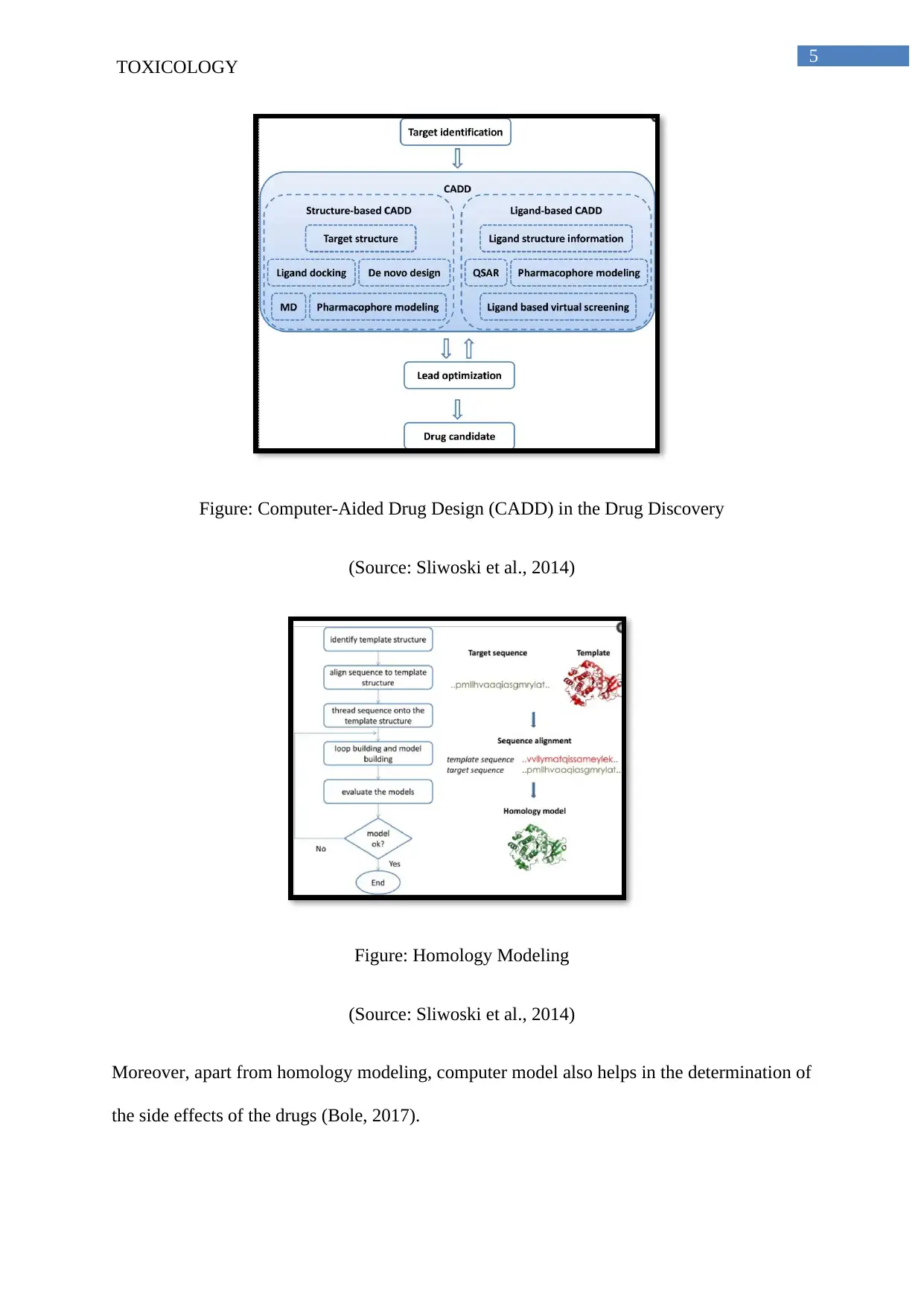
5
TOXICOLOGY
Figure: Computer-Aided Drug Design (CADD) in the Drug Discovery
(Source: Sliwoski et al., 2014)
Figure: Homology Modeling
(Source: Sliwoski et al., 2014)
Moreover, apart from homology modeling, computer model also helps in the determination of
the side effects of the drugs (Bole, 2017).
TOXICOLOGY
Figure: Computer-Aided Drug Design (CADD) in the Drug Discovery
(Source: Sliwoski et al., 2014)
Figure: Homology Modeling
(Source: Sliwoski et al., 2014)
Moreover, apart from homology modeling, computer model also helps in the determination of
the side effects of the drugs (Bole, 2017).
⊘ This is a preview!⊘
Do you want full access?
Subscribe today to unlock all pages.

Trusted by 1+ million students worldwide
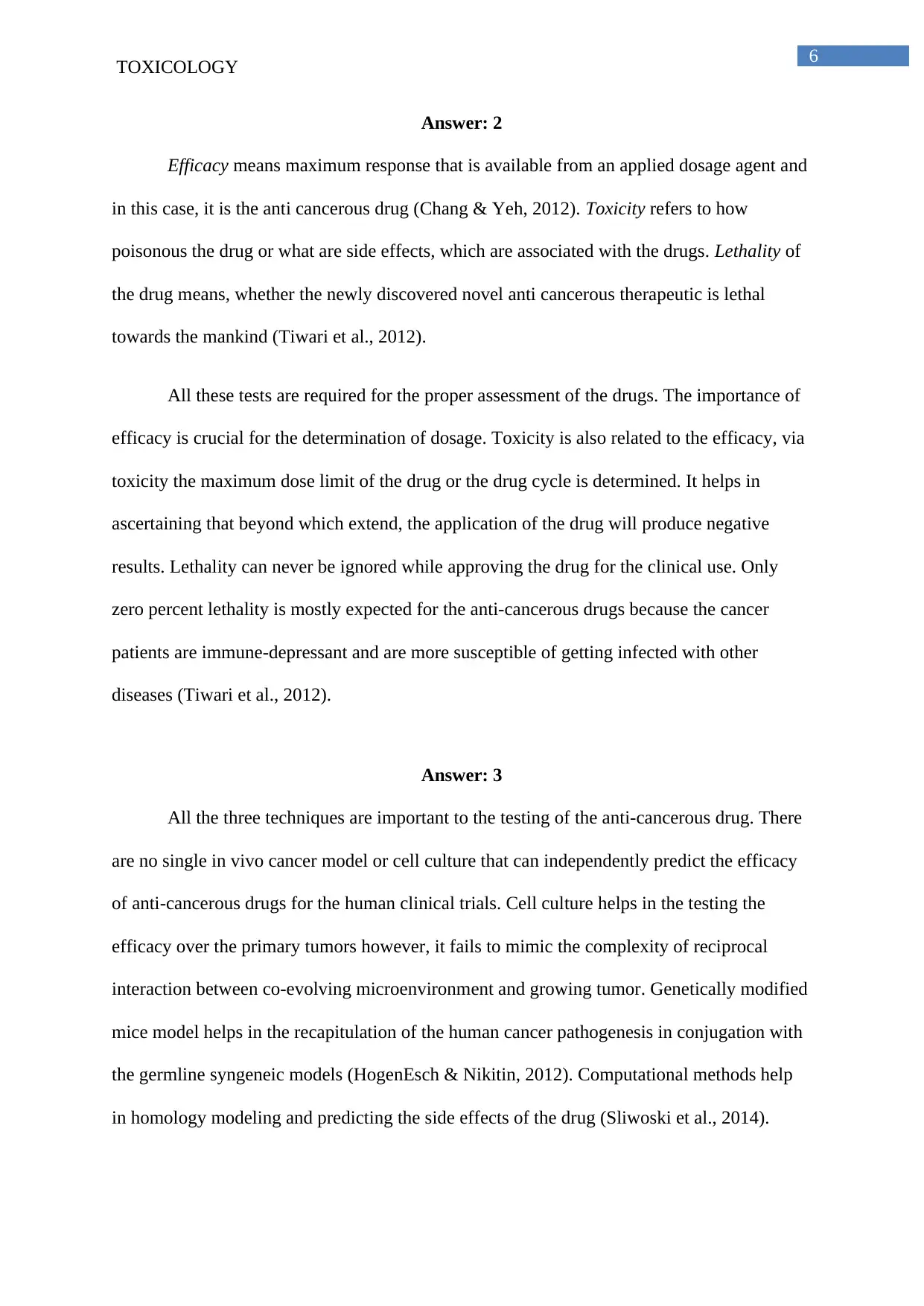
6
TOXICOLOGY
Answer: 2
Efficacy means maximum response that is available from an applied dosage agent and
in this case, it is the anti cancerous drug (Chang & Yeh, 2012). Toxicity refers to how
poisonous the drug or what are side effects, which are associated with the drugs. Lethality of
the drug means, whether the newly discovered novel anti cancerous therapeutic is lethal
towards the mankind (Tiwari et al., 2012).
All these tests are required for the proper assessment of the drugs. The importance of
efficacy is crucial for the determination of dosage. Toxicity is also related to the efficacy, via
toxicity the maximum dose limit of the drug or the drug cycle is determined. It helps in
ascertaining that beyond which extend, the application of the drug will produce negative
results. Lethality can never be ignored while approving the drug for the clinical use. Only
zero percent lethality is mostly expected for the anti-cancerous drugs because the cancer
patients are immune-depressant and are more susceptible of getting infected with other
diseases (Tiwari et al., 2012).
Answer: 3
All the three techniques are important to the testing of the anti-cancerous drug. There
are no single in vivo cancer model or cell culture that can independently predict the efficacy
of anti-cancerous drugs for the human clinical trials. Cell culture helps in the testing the
efficacy over the primary tumors however, it fails to mimic the complexity of reciprocal
interaction between co-evolving microenvironment and growing tumor. Genetically modified
mice model helps in the recapitulation of the human cancer pathogenesis in conjugation with
the germline syngeneic models (HogenEsch & Nikitin, 2012). Computational methods help
in homology modeling and predicting the side effects of the drug (Sliwoski et al., 2014).
TOXICOLOGY
Answer: 2
Efficacy means maximum response that is available from an applied dosage agent and
in this case, it is the anti cancerous drug (Chang & Yeh, 2012). Toxicity refers to how
poisonous the drug or what are side effects, which are associated with the drugs. Lethality of
the drug means, whether the newly discovered novel anti cancerous therapeutic is lethal
towards the mankind (Tiwari et al., 2012).
All these tests are required for the proper assessment of the drugs. The importance of
efficacy is crucial for the determination of dosage. Toxicity is also related to the efficacy, via
toxicity the maximum dose limit of the drug or the drug cycle is determined. It helps in
ascertaining that beyond which extend, the application of the drug will produce negative
results. Lethality can never be ignored while approving the drug for the clinical use. Only
zero percent lethality is mostly expected for the anti-cancerous drugs because the cancer
patients are immune-depressant and are more susceptible of getting infected with other
diseases (Tiwari et al., 2012).
Answer: 3
All the three techniques are important to the testing of the anti-cancerous drug. There
are no single in vivo cancer model or cell culture that can independently predict the efficacy
of anti-cancerous drugs for the human clinical trials. Cell culture helps in the testing the
efficacy over the primary tumors however, it fails to mimic the complexity of reciprocal
interaction between co-evolving microenvironment and growing tumor. Genetically modified
mice model helps in the recapitulation of the human cancer pathogenesis in conjugation with
the germline syngeneic models (HogenEsch & Nikitin, 2012). Computational methods help
in homology modeling and predicting the side effects of the drug (Sliwoski et al., 2014).
Paraphrase This Document
Need a fresh take? Get an instant paraphrase of this document with our AI Paraphraser
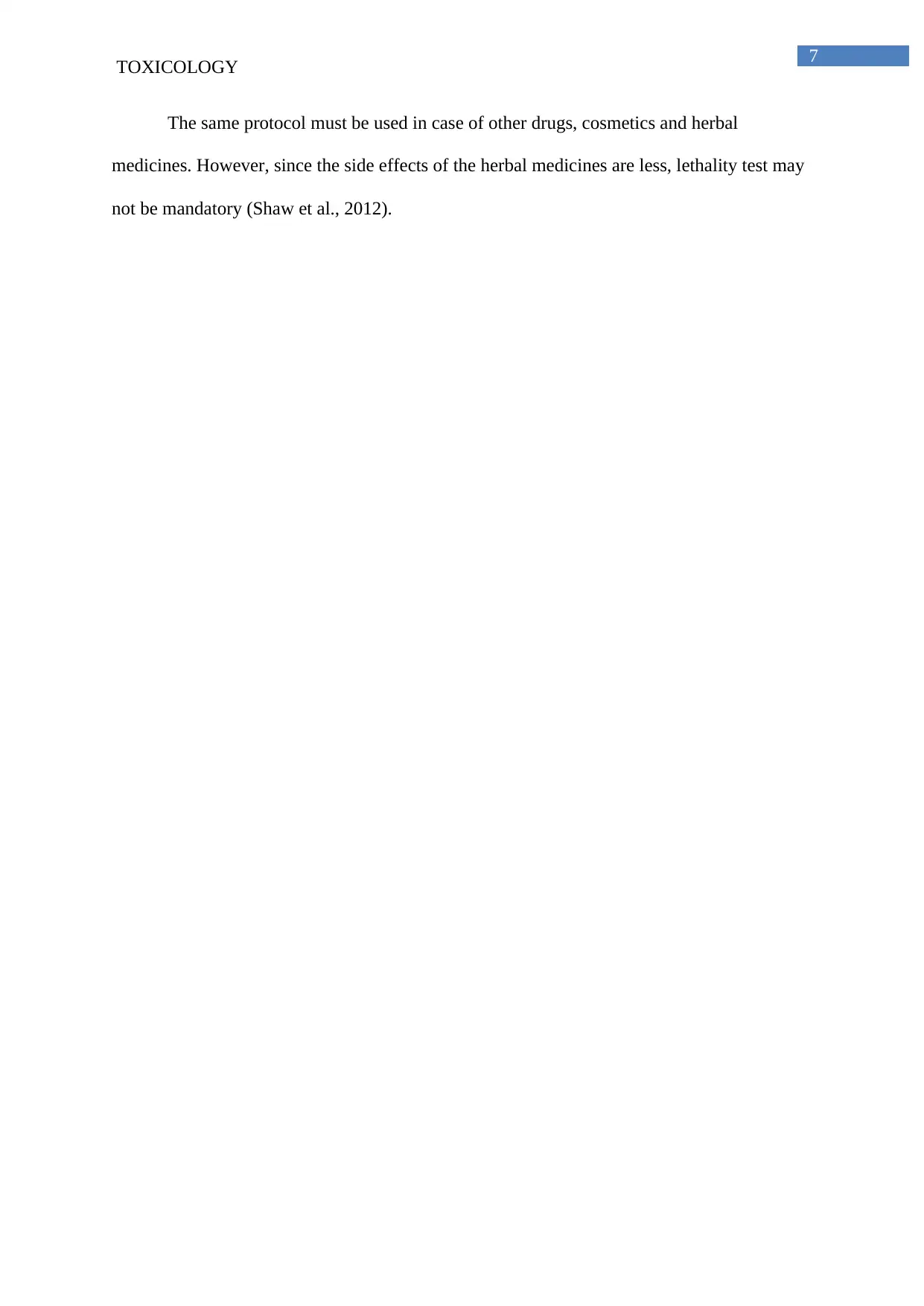
7
TOXICOLOGY
The same protocol must be used in case of other drugs, cosmetics and herbal
medicines. However, since the side effects of the herbal medicines are less, lethality test may
not be mandatory (Shaw et al., 2012).
TOXICOLOGY
The same protocol must be used in case of other drugs, cosmetics and herbal
medicines. However, since the side effects of the herbal medicines are less, lethality test may
not be mandatory (Shaw et al., 2012).
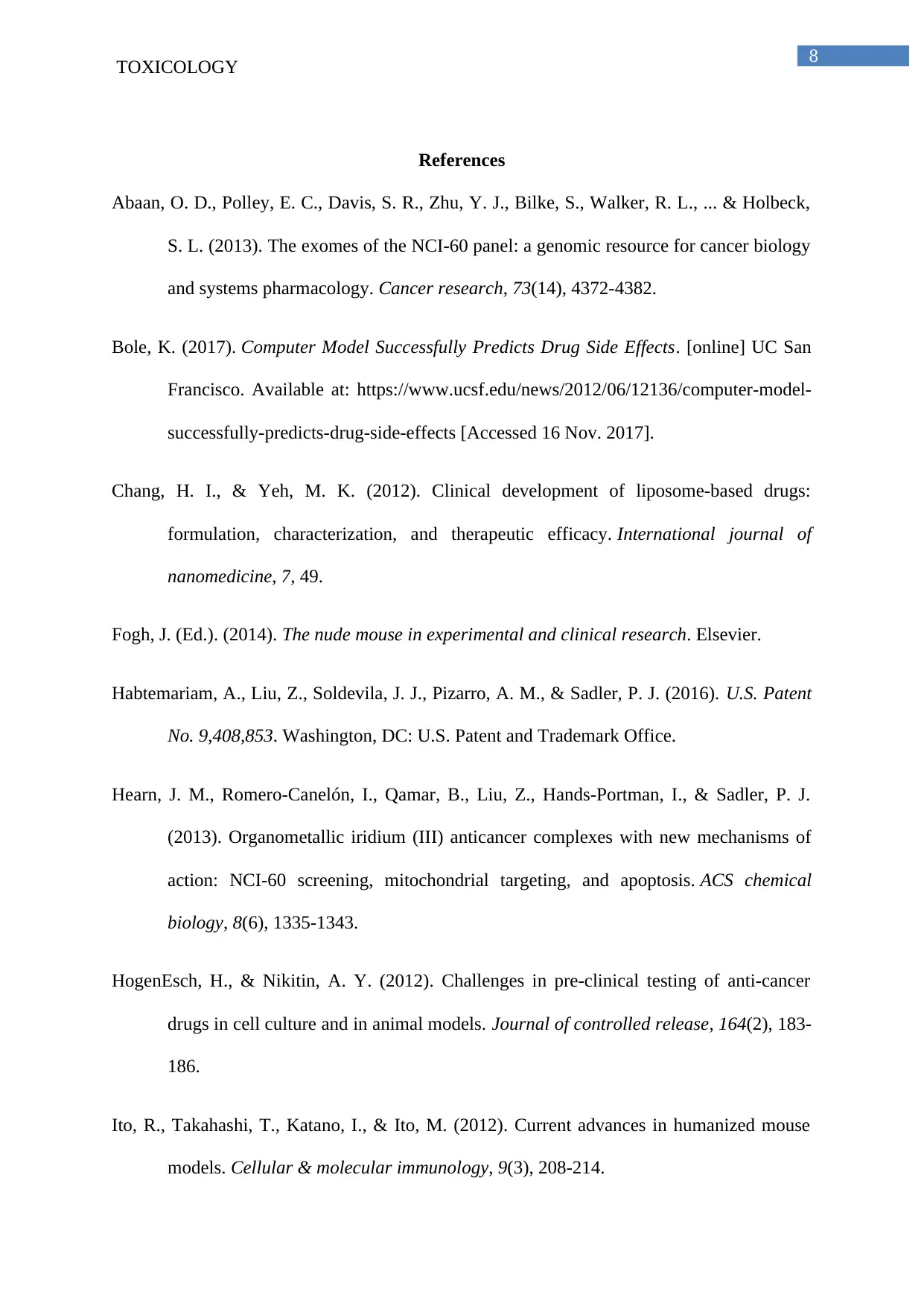
8
TOXICOLOGY
References
Abaan, O. D., Polley, E. C., Davis, S. R., Zhu, Y. J., Bilke, S., Walker, R. L., ... & Holbeck,
S. L. (2013). The exomes of the NCI-60 panel: a genomic resource for cancer biology
and systems pharmacology. Cancer research, 73(14), 4372-4382.
Bole, K. (2017). Computer Model Successfully Predicts Drug Side Effects. [online] UC San
Francisco. Available at: https://www.ucsf.edu/news/2012/06/12136/computer-model-
successfully-predicts-drug-side-effects [Accessed 16 Nov. 2017].
Chang, H. I., & Yeh, M. K. (2012). Clinical development of liposome-based drugs:
formulation, characterization, and therapeutic efficacy. International journal of
nanomedicine, 7, 49.
Fogh, J. (Ed.). (2014). The nude mouse in experimental and clinical research. Elsevier.
Habtemariam, A., Liu, Z., Soldevila, J. J., Pizarro, A. M., & Sadler, P. J. (2016). U.S. Patent
No. 9,408,853. Washington, DC: U.S. Patent and Trademark Office.
Hearn, J. M., Romero-Canelón, I., Qamar, B., Liu, Z., Hands-Portman, I., & Sadler, P. J.
(2013). Organometallic iridium (III) anticancer complexes with new mechanisms of
action: NCI-60 screening, mitochondrial targeting, and apoptosis. ACS chemical
biology, 8(6), 1335-1343.
HogenEsch, H., & Nikitin, A. Y. (2012). Challenges in pre-clinical testing of anti-cancer
drugs in cell culture and in animal models. Journal of controlled release, 164(2), 183-
186.
Ito, R., Takahashi, T., Katano, I., & Ito, M. (2012). Current advances in humanized mouse
models. Cellular & molecular immunology, 9(3), 208-214.
TOXICOLOGY
References
Abaan, O. D., Polley, E. C., Davis, S. R., Zhu, Y. J., Bilke, S., Walker, R. L., ... & Holbeck,
S. L. (2013). The exomes of the NCI-60 panel: a genomic resource for cancer biology
and systems pharmacology. Cancer research, 73(14), 4372-4382.
Bole, K. (2017). Computer Model Successfully Predicts Drug Side Effects. [online] UC San
Francisco. Available at: https://www.ucsf.edu/news/2012/06/12136/computer-model-
successfully-predicts-drug-side-effects [Accessed 16 Nov. 2017].
Chang, H. I., & Yeh, M. K. (2012). Clinical development of liposome-based drugs:
formulation, characterization, and therapeutic efficacy. International journal of
nanomedicine, 7, 49.
Fogh, J. (Ed.). (2014). The nude mouse in experimental and clinical research. Elsevier.
Habtemariam, A., Liu, Z., Soldevila, J. J., Pizarro, A. M., & Sadler, P. J. (2016). U.S. Patent
No. 9,408,853. Washington, DC: U.S. Patent and Trademark Office.
Hearn, J. M., Romero-Canelón, I., Qamar, B., Liu, Z., Hands-Portman, I., & Sadler, P. J.
(2013). Organometallic iridium (III) anticancer complexes with new mechanisms of
action: NCI-60 screening, mitochondrial targeting, and apoptosis. ACS chemical
biology, 8(6), 1335-1343.
HogenEsch, H., & Nikitin, A. Y. (2012). Challenges in pre-clinical testing of anti-cancer
drugs in cell culture and in animal models. Journal of controlled release, 164(2), 183-
186.
Ito, R., Takahashi, T., Katano, I., & Ito, M. (2012). Current advances in humanized mouse
models. Cellular & molecular immunology, 9(3), 208-214.
⊘ This is a preview!⊘
Do you want full access?
Subscribe today to unlock all pages.

Trusted by 1+ million students worldwide
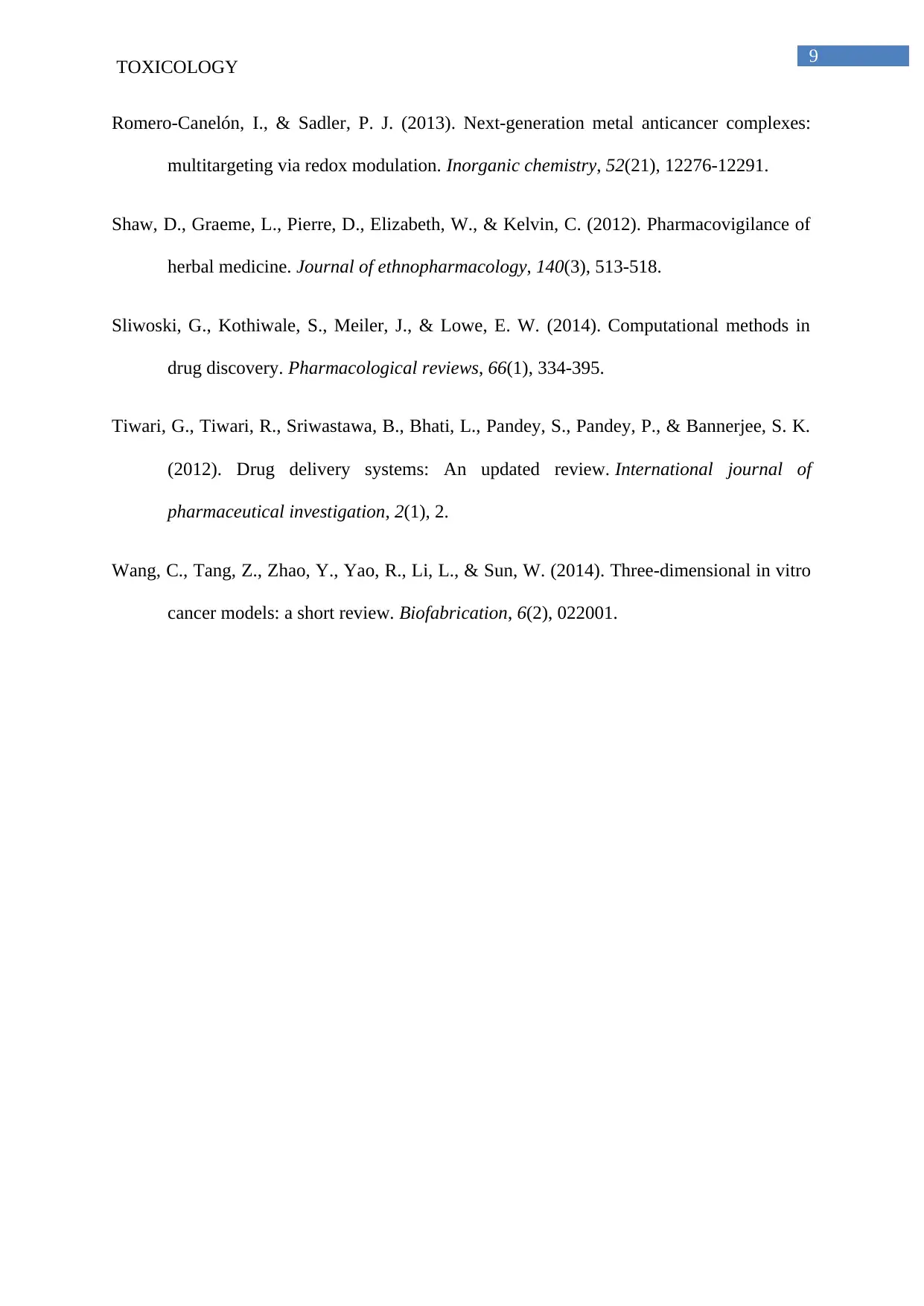
9
TOXICOLOGY
Romero-Canelón, I., & Sadler, P. J. (2013). Next-generation metal anticancer complexes:
multitargeting via redox modulation. Inorganic chemistry, 52(21), 12276-12291.
Shaw, D., Graeme, L., Pierre, D., Elizabeth, W., & Kelvin, C. (2012). Pharmacovigilance of
herbal medicine. Journal of ethnopharmacology, 140(3), 513-518.
Sliwoski, G., Kothiwale, S., Meiler, J., & Lowe, E. W. (2014). Computational methods in
drug discovery. Pharmacological reviews, 66(1), 334-395.
Tiwari, G., Tiwari, R., Sriwastawa, B., Bhati, L., Pandey, S., Pandey, P., & Bannerjee, S. K.
(2012). Drug delivery systems: An updated review. International journal of
pharmaceutical investigation, 2(1), 2.
Wang, C., Tang, Z., Zhao, Y., Yao, R., Li, L., & Sun, W. (2014). Three-dimensional in vitro
cancer models: a short review. Biofabrication, 6(2), 022001.
TOXICOLOGY
Romero-Canelón, I., & Sadler, P. J. (2013). Next-generation metal anticancer complexes:
multitargeting via redox modulation. Inorganic chemistry, 52(21), 12276-12291.
Shaw, D., Graeme, L., Pierre, D., Elizabeth, W., & Kelvin, C. (2012). Pharmacovigilance of
herbal medicine. Journal of ethnopharmacology, 140(3), 513-518.
Sliwoski, G., Kothiwale, S., Meiler, J., & Lowe, E. W. (2014). Computational methods in
drug discovery. Pharmacological reviews, 66(1), 334-395.
Tiwari, G., Tiwari, R., Sriwastawa, B., Bhati, L., Pandey, S., Pandey, P., & Bannerjee, S. K.
(2012). Drug delivery systems: An updated review. International journal of
pharmaceutical investigation, 2(1), 2.
Wang, C., Tang, Z., Zhao, Y., Yao, R., Li, L., & Sun, W. (2014). Three-dimensional in vitro
cancer models: a short review. Biofabrication, 6(2), 022001.
1 out of 10
Your All-in-One AI-Powered Toolkit for Academic Success.
+13062052269
info@desklib.com
Available 24*7 on WhatsApp / Email
![[object Object]](/_next/static/media/star-bottom.7253800d.svg)
Unlock your academic potential
© 2024 | Zucol Services PVT LTD | All rights reserved.


